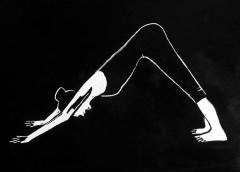|
Yoga

Yoga, originating in ancient India, is a group of spiritual practices for the purpose of cultivating a steady mind. It has been defined as technologies or disciplines of asceticism and meditation thought to lead to spiritual experiences and understanding into the nature of existence. Outside India, however, it is mostly associated with the practice of asanas (postures) of Hatha or as a form of exercise. Post-workout stretching, martial arts conditioning, and flexibility positions seen in various athletic training programs are similar or even identical to many Hatha postures or poses. Yoga for seniors classes typically begin with modified and age-appropriate poses and movement. Watch a short poses demonstration video by Jennifer Franklin Gordon. Many different styles are taught and practiced today. Yet all are based on the same physical postures or poses. The difference being that each style has a particular emphasis. The following is a brief overview of popular disciplines, listed alphabetically . . . •Ananda classes focus on gentle postures designed to move energy to the brain and prepare your body for meditation. They focus on proper body alignment and controlled breathing. •Anusara is a newer form (1997) combining a strong emphasis on physical alignment with a playful spirit. Anusara classes are said to be light-hearted and accessible to students of differing abilities. •Ashtanga is a physically demanding style and also the inspiration for what is often called “Power Yoga.” It involves synchronized breathing with a progressive and continuous series of postures. It is an athletic practice probably not suitable for beginners. •Bikram is often referred to as “Hot Yoga,” as it practiced in a 95 to 100 degree room, which allows for loosening tight muscles and profuse sweating. Founded by a former gold medal Olympic weight lifter (1963), Bikran is said to be a comprehensive workout that includes all the components of an over all fitness workout. •Hatha is an easy-to-learn basic form that is very popular in the United States and is the foundation for all other styles. It incorporates Asanas (postures), regulated breathing, meditation, and kundalini (Laya) into a complete system. •Integral is a traditional type of hatha practice that combines postures, breathing exercises, selfless service, meditation, chanting, prayer, and self-inquiry. •ISHTA stands for Integral Science of Hatha and Tantric Arts. It focuses on opening energy channels throughout the body with postures, visualizations, and meditation. •Iyengar promotes strength, flexibility, endurance, and balance through coordinated breathing and poses that require precise body alignment. The poses are generally held longer than in other styles. Equipment such as cushions, blankets, straps, and blocks help the less flexible and distinguishes Iyengar from other types. It is one of the most popular kinds of schools practiced today. •Jivamukti expresses the spiritual and ethical aspects of Yoga that many think have been disregarded or devalued today. It is vigorous and challenging and with an emphasis on scriptural study, Sanskrit chanting, vegetarianism, non-violence, meditation, and devotion to God. •Kundalini emphasizes breath in conjunction with movement for the purpose of freeing energy in your lower body and allowing it to move upwards. Kundalini uses rapid, repetitive movements rather than poses held for longer periods. The teacher will often lead a class in call and response chanting. •Sivananda is based on five principals: 1) Asana (focusing on 12 poses in particular); 2) Pranayama (proper breathing; 3) Savasana (relaxation); 4) Vegetarianism; and 5) Dhyana (positive thinking and meditation). •Vinyasa, like Hatha, is a general term describing many different types of classes. Vinyasa tends to be a more vigorous style based on the performance of a series of poses called “Sun Salutations,” in which movement is matched to breath.
Seniors: If you are a senior beginner, ask your instructor or school about instruction or classes for seniors.
|